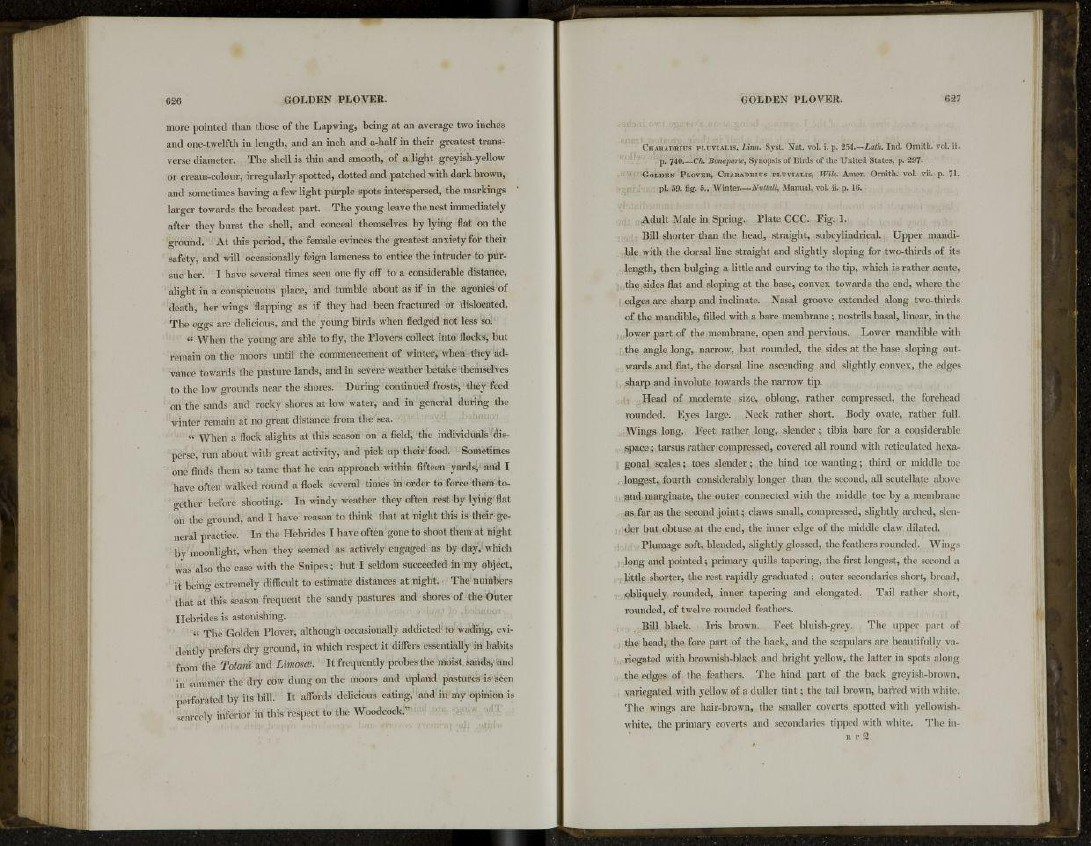
626 GOLDEN PLOVER.
more pointed than those of the Lapwing, being at an average two inches
and one-twelfth in length, and an inch and a-half in their greatest transverse
diameter. The shell is thin and smooth, of a light greyish-yellow
or cream-colour, irregularly spotted, dotted and patched with dark brown,
and sometimes having a few light purple spots interspersed, the markings
larger towards the broadest part. The young leave the nest immediately
after they burst the shell, and conceal themselves by lying flat on the
ground. At this period, the female evinces the greatest anxiety for their
safety, and will occasionally feign lameness to entice the intruder to pursue
her. I have several times seen one fly off to a considerable distance,
alight in a conspicuous place, and tumble about as if in the agonies of
death, her wings flapping as if they had been fractured or dislocated.
The eggs are delicious, and the young birds when fledged not less so.
" When the young are able to fly, the Plovers collect into flocks, but
remain on the moors until the commencement of winter, when they advance
towards the pasture lands, and in severe weather betake themselves
to the low grounds near the shores. During continued frosts, they feed
on the sands and rocky shores at low water, and in general during the
winter remain at no great distance from the sea.
" When a flock alights at this season on a field, the individuals disperse,
run about with great activity, and pick up their food. Sometimes
one finds them so tame that he can approach within fifteen yards, and I
have often walked round a flock several times in order to force them together
before shooting. In windy weather they often rest by lying flat
on the ground, and I have reason to think that at night this is their general
practice. In the Hebrides I have often gone to shoot them at night
by moonlight, when they seemed as actively engaged as by day, which
was also the case with the Snipes; but I seldom succeeded in my object,
it being extremely difficult to estimate distances at night. The numbers
that at this season frequent the sandy pastures and shores of the Outer
Hebrides is astonishing.
" The Golden Plover, although occasionally addicted to wading, evidently
prefers dry ground, in which respect it differs essentially in habits
from the Totani and Limosce. It frequently probes the moist sands, and
in summer the dry cow dung on the moors and upland pastures is seen
perforated by its bill. It affords delicious eating, and in my opinion is
•scarcely inferior in this respect to the Woodcock."
GOLDEN PLOVER. 627
CHARADRIUS PLUVIALIS, Linn. Syst. Nat. vol. i. p. 254.—Lath. Ind. Ornith. vol. ii.
p. 740—Ch. Bonaparte, Synopsis of Birds of the United States, p. 297-
GOLDEN PLOVER, CHARADRIUS PLUVIALIS, Wils. Amer. Ornith. vol. vii. p. 71.
pi. 59. fig. 5., Winter.—Nuttall, Manual, vol. ii. p. 16.
Adult Male in Spring. Plate CCC. Fig. 1,
Bill shorter than the head, straight, subcylindrical. Upper mandible
with the dorsal line straight and slightly sloping for two-thirds of its
length, then bulging a little and curving to the tip, which is rather acute,
the sides flat and sloping at the base, convex towards the end, where the
edges are sharp and inclinate. Nasal groove extended along two-thirds
of the mandible, filled with a bare membrane; nostrils basal, linear, in the
lower part of the membrane, open and pervious. Lower mandible with
the angle long, narrow, but rounded, the sides at the base sloping outwards
and flat, the dorsal line ascending and slightly convex, the edges
sharp and involute towards the narrow tip.
Head of moderate si/.e, oblong, rather compressed, the forehead
rounded. Eyes large. Neck rather short. Body ovate, rather full.
Wings long. Feet rather long, slender; tibia bare for a considerable
space; tarsus rather compressed, covered all round with reticulated hexagonal
scales; toes slender; the hind toe wanting; third or middle toe
longest, fourth considerably longer than the second, all scutellate above
and marginate, the outer connected with the middle toe by a membrane
as far as the second joint; claws small, compressed, slightly arched, slender
hut obtuse at the end, the inner edge of the middle claw dilated.
Plumage soft, blended, slightly glossed, the feathers rounded. Wings
long and pointed; primary quills tapering, the first longest, the second a
little shorter, the rest rapidly graduated ; outer secondaries short, broad,
obliquely rounded, inner tapering and elongated. Tail rather short,
rounded, of twelve rounded feathers.
Bill black. Iris brown. Feet bluish-grey. The upper part of
the head, the fore part of the back, and the scapulars are beautifully variegated
with brownish-black and bright yellow, the latter in spots along
the edges of the feathers. The hind part of the back greyish-brown,
variegated with yellow of a duller tint; the tail brown, barred with white.
The wings are hair-brown, the smaller coverts spotted with yellowishwhite,
the primary coverts and secondaries tipped with white. The in